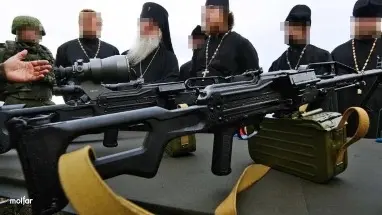In its 2020 report, “Moscow’s Mercenary Wars: The Expansion of Russian Private Military Companies” (PMCs), the US think tank Center for Strategic and International Studies detailed the growth in the use of PMCs to fight the Kremlin’s wars and highlighted the links between these companies and Russia’s military and intelligence apparatus.
Since the start of the war in Ukraine, the largest and most notorious of these groups, the Wagner PMC, hit the headlines through a combination of bragging about its prowess by its leader, Yevgeny Prigozhin, and his public spats with Russia’s military leadership, which culminated in his failed June mutiny and his own eventual demise.
JOIN US ON TELEGRAM
Follow our coverage of the war on the @Kyivpost_official.
As a result, it was reported that the Kremlin has been reviewing the legal status of its many PMCs especially after both President Putin and his spokesman, Dmitry Peskov, had said that “legally, the Wagner private military group does not exist and has never existed.”
Peskov told reporters that the status of companies such as Wagner remains “rather complicated,” while Putin said that the legalization of PMCs was a matter for the Duma, Russia’s parliament.
MOLFAR, is an open-source investigation organization whose output has proven to be largely accurate, reliable, and whose data is widely used by international media and other resources. Since Russia’s full-scale invasion it has switched much of its focus on military investigations, propaganda refutation, war criminal identification, and geospatial intelligence relating to Moscow’s forces in Ukraine.

Drone Wars –Technology, Tactics, Strategy, Countermeasures, Legislation
Earlier this year MOLFAR published a catalog of Russian PMCs, which identified 37 separate mercenary groups operating in as many as 34 different countries with more than two thirds of their funding coming from the state with the rest from oligarchs and other unspecified sources.
Buried in this report was reference to a PMC called Andreyevsky Krest (St Andrew’s Cross) which it said was funded by donations collected by the Russian Orthodox Church (ROC) from its congregations throughout the federation.
A Russian Telegram channel, MASH, had reported in November 2022 that the ROC was funding training for those called up as part of Russia’s 2022 autumn mobilization and were receiving blessings from a bishop of the church, Archimandrite Alexy, suggesting that they were being prepared by the ROC for a “religious crusade.”
Recent revelations by Ukrainian intelligence agencies suggests that the ROC’s role may be a lot more than just gathering funds.
Andriy Yusov, the spokesman for the Ukrainian Military Intelligence Directorate (HUR), speaking on Ukraine’s national telethon on Thursday, said unequivocally that Kyiv considers the ROC to have “nothing to do with faith and religion,” adding: “This is a branch of Russian intelligence.”
He went on to say that “It is not news that previously, individuals from this organization publicly and officially participated in hostilities, blessed and consecrated missiles, weapons, took part in the training for Russian military, and motivated ordinary residents of the Russian Federation to engage in the genocide against Ukrainians.”
Earlier in the day posts began to appear on Ukrainian Telegram channels citing reports by the Security Service of Ukraine (SBU) that the Andreyevsky Krest was a full-blown PMC operating from its base located at the Kronstadt Naval Cathedral in St Petersburg.
Representatives of the cathedral were said to be actively recruiting parishioners, particularly those with previous military experience, for service in Ukraine. Military tactical and firearms training courses were reportedly being held for mercenaries by instructors from the Russian special services.
The SBU asserted that “to disguise combat training, their organizers train their ‘recruits’ exclusively within the walls of the cathedral and at special training grounds in Russia.”
The statement continued: “It has been established that these private military companies are being financed by representatives of financial and industrial groups of the aggressor country that are close to the head of the Kremlin. The money goes to Russian Orthodox Church accounts in the form of charitable contributions and donations to build churches.”
The SBU said that this was yet another criminal activity undertaken by the ROC that would be investigated. Ukraine has initiated proceedings against 68 representatives of the Ukrainian Orthodox Church of the Moscow Patriarchate, Russia’s subordinate church on Ukrainian territory, for crimes including high treason, collaboration and providing aid and comfort to agents of the aggressor country.
The Russian news site Meduza reported that head of the ROC, Patriarch Kirill of Moscow, said in a sermon on Sept. 22: “We know that many today are dying in the fields of internecine battle. The Church is praying that this battle will end as soon as possible…”
Kirill went as far as equating death in Russia’s military campaign as a sacrifice worthy of full absolution: “If someone, driven by a sense of duty and the need to honor his oath, stays loyal to his vocation and dies while carrying out his military duty, then he is, without any doubt, doing a deed that is equal to sacrifice. He is sacrificing himself for others. And, therefore, we believe that this sacrifice cleanses away all of that person’s sins.”
You can also highlight the text and press Ctrl + Enter






